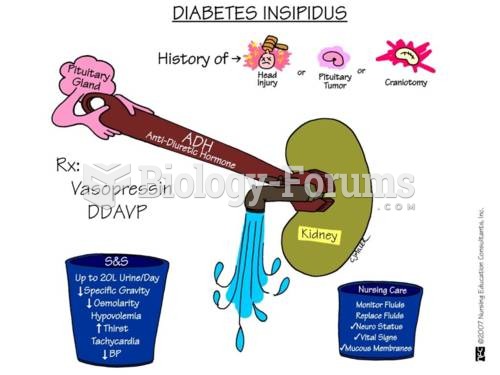Answer to Question 1
Background retinopathy affects the capillary endothelium and results in a breakdown of the blood-retinal barrier. As plasma leaks from the compromised capillaries, macular edema and subsequent loss of vision result. In proliferative retinopathy, neovascularization is responsible for visual change. These new vessels tend to bleed into the vitreous cavity and decrease visual acuity. Because of their mode of attachment, these new vessels also have the tendency to adhere the vitreous to the surface of the retina. As the vitreous moves, it exerts mechanical forces on the retina, leading to retinal detachment and progressive loss of vision.
The neural retina receives nutrients from the choroid. When the neural retina is detached from the pigment layer, the transport of nutrients is severed. With prolonged detachment, the receptors of the neural retina become ischemic, die, and cause loss of vision in that portion of the retina.
Traction retinal detachment is a result of mechanical forces that pry the retina away from the choroid. The traction forces are frequently from the lay down of fibrotic tissue that have developed secondary to injury, infection, or inflammation. In rhegmatogenous detachment, a retinal tear is present. The detachment occurs when the liquid vitreous enters the tear and separates the neural retina from the pigment layer.
Answer to Question 2
Allan is experiencing the symptoms of Mnire disease. The disease is thought to result from the impaired filtration and excretion of the endolymphatic sac. The condition may be exacerbated by an abnormal increase in endolymph production. This excessive production may occur on its own, or as a compensatory mechanism for an abnormal decrease in perilymph.
The sensory cells of the utricle and saccule respond to static head position in relation to gravitational pull. They also provide sensory input for changes in linear motion and changes in head position.
The semicircular canals are positioned to detect rotational movements of the head. They sense head tilting with acceleration and detect turning movements in concert with locomotion.
Endolymph is a potassium-rich fluid contained in the scala media of the cochlea. It receives sound waves as they pass through the perilymph of the scala vestibuli and translate across the vestibular membrane. When the endolymph is set in motion, the basilar membrane vibrates and the receptor cells in spiral organ of Corti are stimulated so that the perception of sound occurs.
The endolymphatic potential exists because of an electrolyte gradient in the cochlear apparatus, maintained by Na+/K+ active transport pumps. The resting membrane potential between endolymph and perilymph acts to sensitize the hair cells of the spiral organ of Corti, allowing them to perceive the quietest of sounds.






